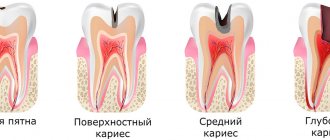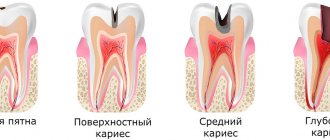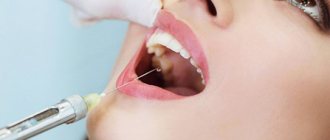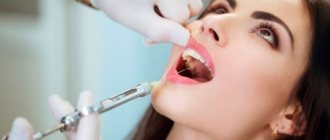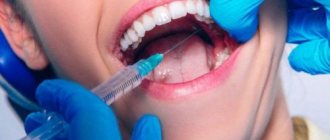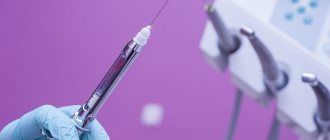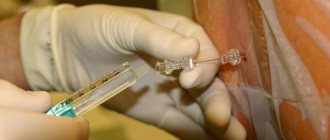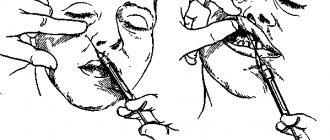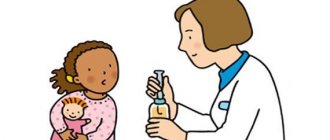Anesthesia without adrenaline has been used in dentistry for quite a long time; it allows painless treatment even for those patients who have contraindications to common means of local anesthesia. Typically, drugs that do not contain adrenaline are used in cases where it is necessary to treat teeth in patients with high blood pressure, heart disease, and pregnant or breastfeeding women.
What is Articaine and what is its composition?
Articaine is an amide anesthetic intended for local, infiltrative or conductive anesthesia for both simple and complex dental procedures. A local anesthetic blocks the generation and conduction of nerve impulses, presumably by increasing the threshold of electrical excitation in the nerve, slowing the propagation of the nerve impulse, and decreasing the rate of rise of the action potential.
The uniqueness of Articaine as a member of the amide family is that it contains an ester group and a thiophene instead of a benzene ring. The thiophene ring increases the lipid solubility of articaine, facilitating more efficient diffusion of the anesthetic across the lipid membrane of nerve cells into surrounding tissues. Articaine is widely used in dentistry due to its safety during short procedures that require rapid onset of anesthesia.
The onset of action of the drug Articaine is:
- from 1.5 to 1.8 min. with infiltration of the upper jaw;
- from 1.5 to 3.6 min. with block anesthesia of the lower jaw.
Articaine pulp anesthesia lasts from 30 to 120 minutes. Anesthesia of soft tissues with the drug lasts ~ 2.25 hours for infiltration of the upper jaw, 4 hours for blockade of the lower jaw.
The drug is produced in the form of an injection solution - a transparent, colorless or yellowish liquid. For retail sale to pharmacy chains, Articaine is supplied in ampoules made of colorless chemically pure glass, enclosed in blister packs and/or cardboard packs.
Composition of articaine in dentistry:
- active agent - articaine hydrochloride;
- Excipients: sodium chloride (to make the solution isotonic) and distilled water.
1 ml of solution contains 40 mg of active agent.
In odonto-dental anesthesia, articaine is used alone or in combination with epinephrine (adrenaline). Epinephrine, diluted to 1:100,000 or 1:200,000 and added to the solution, slows down the passage of articaine into the general bloodstream and thus ensures long-term maintenance of the concentration of the active substance in the tissues, allowing a small hemorrhagic surgical field to be obtained.
It is possible to replace Articaine with synonyms with the same active substance, such as:
- Artikain-Binergy;
- Ultracaine;
- Artikain-DF;
- Articaine with Epinephrine.
The decision to use analogues is made by the attending physician, taking into account the individual characteristics of the patient.
Cost of anesthetics and anesthesia
The cost of one carpule of anesthetic is approximately 10-20 UAH. Carrying out one anesthesia in a dental clinic will cost an average of 130 UAH.
What to do if you are afraid of anesthesia
Many people are afraid of injections, because each person has their own pain sensitivity threshold. During anesthesia, the pain from the injection may depend on the professionalism of the doctor, the anesthesia technique, and also on the speed of administration of the anesthetic. An experienced doctor does not save time and administers painkillers for at least 40 seconds. Immediately before the injection, you can ask the doctor to treat the area of the upcoming injection with an anesthetic spray (for example, Lidocaine spray).
Manufacturers Articaine
On the Russian pharmaceutical market, the anesthetic Articaine and its analogues are represented by domestic and foreign manufacturers. You can buy articaine in St. Petersburg and Moscow using the link.
The products of the following enterprises are most in demand:
- JSC "Biokhimik" (Russia);
- CJSC "Binergy" (Russia);
- LABORATORY INIBSA, SA (Spain);
- Welfarm LLC (Russia);
- Armavir biofactory FKP (Russia);
- Borisov Medical Preparations Plant (Republic of Belarus);
- Sanofi-Aventis Deutschland GmbH (Germany).
Preparations based on articaine, created at different enterprises, may have certain differences due to production technology, quantitative and qualitative composition of excipients, but at the same time retain the main direction of action of the active substance.
How to improve the quality of pain relief?
A patient who is indicated for anesthesia without adrenaline in dentistry can make sure that the effect of the painkiller lasts longer and is of better quality. To do this, he only needs to follow a few general recommendations:
- Before visiting a doctor, if there is strong anxiety and fear of treatment, it is better to take a sedative, preferably based on herbs (for example, about 30 drops of valerian root tincture).
- The day before visiting the dentist, you should not drink alcohol, since alcohol in the blood weakens the effect of the anesthetic.
- If you are taking any medications or have any allergic reactions, you should inform your dentist at the treatment planning stage.
- It is better not to visit a doctor if you feel unwell or during menstruation.
Articaine: side effects
Such qualities of Artican as low fat solubility, high% binding to blood proteins, low half-life ensure low toxicity of the drug. However, depending on the general condition, age, individual reactions of the patient and his existing systemic diseases, side effects may be observed during anesthesia with the drug, such as:
- disturbance or confusion;
- vertigo;
- headache;
- nausea;
- dyspnea;
- decreased blood pressure;
- diplopia;
- muscle tremors;
- allergic and local reactions, manifested in symptoms of urticaria, conjunctivitis, rhinitis, skin hyperemia, swelling and inflammation at the injection site.
Articaine should be used with caution during dental procedures in patients with impaired cardiovascular function, vascular diseases, liver and kidney failure.
Articaine during pregnancy in dentistry
Articaine is usually well tolerated at all stages of pregnancy. There is no data on the long-term effects of the drug on the neurophysiology of the newborn. Also, no teratogenic damage was observed after use of the drug in the first trimester.
There are no data from clinical studies of the penetration of Articaine into breast milk. To minimize possible risk to the baby, breastfeeding mothers may choose to express milk for approximately 4 hours after the injection. After which breastfeeding can be resumed.
Instructions for use
To exclude or minimize intravascular administration of Articaine, an aspiration test is required before using the drug. An accurate and slow technique for injecting the drug is required with control of the pressure on the syringe plunger depending on the sensitization of the tissue.
The instructions for use in dentistry recommend using Articaine in a dosage corresponding to the nature of the manipulation:
- 1.7 ml of solution per tooth for uncomplicated extraction of the upper jaw tooth;
- 0.1 ml for anesthetizing incisions when creating a palatal depot and suturing;
- 0.5-1.7 ml per tooth for grinding teeth for crowns and in case of cavity preparation.
After each injection of Articaine, careful and constant monitoring of vital signs of the cardiovascular and respiratory systems (adequacy of ventilation) and the patient’s state of consciousness should be carried out.
using Articaine in dentistry for infiltration anesthesia during extirpation of mandibular premolars.
Types of pain relief
Dentists, as a rule, provide drug local anesthesia, which involves injecting the drug into the tissue in the treatment area. The effect of the product lasts for a certain time required by the specialist to perform the treatment procedure. After a short period of time, the drug is eliminated from the body, and tissue sensitivity is restored.
Treatment under general anesthesia is rarely performed. It is often used in complex jaw surgery operations.
Local anesthesia
Local anesthesia is almost always performed during dental treatment. It causes less stress to the body, so it is used even for children. A few years ago, only injections of Novocaine and Lidocaine were used. However, today different substances and their forms are used for pain relief.
- Application anesthesia
Anesthesia provides a superficial decrease in sensitivity. A special spray, gel or ointment is applied to the causative area of the oral cavity. A common substance is a solution of Lidocaine, produced in the form of an aerosol. This type of sensitivity reduction is indicated for manipulations with a minor degree of intervention, for example, when removing stone or preparing the dentition for prosthetics.
The concentrated drug penetrates the tissue by 2-3 mm and blocks nerve endings. The effect is noticeable within a few minutes and lasts half an hour to an hour. The anesthetic is not absorbed into the circulatory system, therefore the method is considered the safest. Other disadvantages of topical anesthesia include the insignificant depth of anesthesia and the short duration of its action.
- Infiltration anesthesia
Such anesthesia makes it possible to reduce the sensitivity of one element of the dentition or a small area of periodontal tissue. Such anesthesia is recommended for depulpation or when treating teeth severely damaged by caries.
The drug is injected into the root apex area. The substance does not allow the passage of a pain impulse in the area of the nerve branch. The method is recommended for the treatment of upper teeth, since the bone skeleton of the upper jaw is thinner and allows easy access to the nerves. The disadvantages of the method include the need to use a significant amount of anesthetic if it is necessary to anesthetize a large area. There is also a high risk of soft tissue deformation (swelling) at the injection site, which may interfere with the effective implementation of the procedure.
- Conduction anesthesia
This anesthesia is used to anesthetize several dental elements located in a row “in the neighborhood.” This method of reducing sensitivity is used during tooth extraction, puncture of inflammation, acute periodontitis and when installing a drainage system in a purulent focus. A properly selected anesthetic temporarily reduces the sensitivity of an entire nerve branch. The disadvantage of the technique is the high risk of injury to the nerve and vascular network. Manipulations require specialist skills.
- Intraligament method
When treating children's teeth, an intraligamentous method of pain relief is used. The substance is injected into the periodontal zone, near the alveoli and tooth root. With this method, the mucous membrane does not lose sensitivity, so the risk of the baby biting the mucous membrane and lips is reduced.
- Intraosseous anesthesia
This type of sensitivity reduction is indicated when tooth extraction is necessary. The substance is injected into the gum, reducing the sensitivity of the target tooth and gum area. Pain relief occurs very quickly, but the effect does not last long.
- Trunk anesthesia
With this type of anesthesia, the trigeminal nerve and its branches at the base of the skull are blocked. This radical method is used for extensive operations in dentistry and jaw surgery. The duration of anesthesia is increased due to the vasoconstrictor. Trunk anesthesia affects both jaws. The patient is constantly monitored.
When is pain relief not performed?
Before using this or that drug, the dentist finds out whether the patient has mental illnesses or allergic reactions. Drug pain relief is not used if:
- allergy;
- cardiac ailments;
- diabetes;
Important: Drug pain relief is administered to pregnant women and nursing mothers with extreme caution.
In some cases, when anesthesia is contraindicated, drugs are used in dentistry to relieve the patient of anxiety. Sedatives reduce fear, are not hypnotics, and give good results. They are prescribed by the dentist depending on the need.
What drugs are used in dentistry for pain relief?
Novocaine and Lidocaine have already been mentioned. In modern practice they are used less and less. Experts prefer modern anesthetics: Articaine, Ultracaine, Scandonest, Septonest.
Anesthesia drugs in dentistry are prepared in capsules, which are placed in the body of a syringe with a thin needle.
What complications can arise when using painkillers in dentistry?
Common side effects when using anesthesia include:
- allergic reactions due to individual intolerance to the drug;
- poisoning (when using an overdose);
- nerve injury from a needle (in case of violation of the local anesthesia protocol).
The following manifestations and conditions may also be observed after an injection:
- swelling and hematomas due to damage to the blood branch;
- infection of tissues at the site of drug administration due to the doctor’s violation of the rules of asepsis and antisepsis;
- trismus due to nerve damage;
- biting soft tissues due to loss of sensitivity after administration of the drug.
How to prepare for anesthesia?
It is recommended to refrain from drinking alcohol two to three days before the procedure, as ethyl alcohol reduces the effect of the drugs. If you're nervous about your upcoming dental visit, take a sedative at night. Dental treatment is not carried out against the background of colds.
General anesthesia
Anesthesia is a complete (temporary) loss of sensitivity in a patient, which is accompanied by impaired consciousness of varying degrees. This method of pain relief is rarely used in dentistry.
The indication for general anesthesia is one of the following conditions:
- intolerance to local anesthetic drugs;
- mental conditions and disorders;
- pathological fears of dental procedures.
Before visiting a dentist, if procedures are to be performed under local anesthesia, the patient is required to undergo a medical examination:
- ECG and consultation with a cardiologist;
- laboratory blood tests;
- consultation with a therapist.
Before visiting the dentist's office, you should avoid drinking alcohol. Eating on the eve of the visit and in the morning is contraindicated. General anesthesia is carried out only by an anesthesiologist in the presence of a resuscitator.
Articaine in pediatric dentistry
The pharmacodynamics of local anesthetics in children is comparable to that in adults. In pediatric dental practice, extreme caution must be exercised when using amide local anesthetics as lower intrinsic clearance or decreased serum protein binding may easily lead to an increased risk of toxic reactions. The route of administration is one of the main safety factors when using local anesthetics in neonates and children.
Anesthesia in dentistry with the drug Articaine , carried out using intraosseous injection, is effective in achieving deep anesthesia of teeth affected by MIG with hypersensitivity associated with chronic inflammation of the pulp in children.
In pediatric dentistry, it is recommended to use Articaine 2% due to the lower Cmax and shorter half-life of the drug.
Why is adrenaline needed in anesthesia?
Adrenaline is a vasoconstrictor - a substance that narrows blood vessels. Therefore, on the one hand, its presence in the drug provides a longer-lasting analgesic effect, and on the other hand, it reduces the risk of bleeding during dental procedures (for example, during tooth extraction).
Given this, dentists always warn patients that anesthesia without epinephrine in dentistry has a shorter lasting effect and is not suitable for long procedures. In cases where the patient is indicated for pain relief using non-adrenaline anesthetics, treatment must be carried out very quickly or divided into stages so that the doctor has the opportunity to provide anesthesia before each subsequent stage of manipulation.
If you have a problem similar to that described in this article, be sure to contact our specialists. Don't diagnose yourself!
Why you should call us now:
- We will answer all your questions in 3 minutes
- Free consultation
- The average work experience of doctors is 12 years
- Convenient location of clinics
Single contact phone number: +7
Make an appointment
Reviews from dentists about the drug Articaine
Most practicing dentists consider Articaine to be the best representative of local anesthetics due to its high effectiveness. At the same time, when using the medication, there is a low incidence of allergic reactions, the possibility of safe use in pregnant women, and the absence of addiction. The only small drawback of Articaine, according to experts, is the inability to prescribe it to children under 4 years of age. In all other cases, Articaine is rightly called one of the drugs of choice.
This information is intended for medical professionals and specialists.
